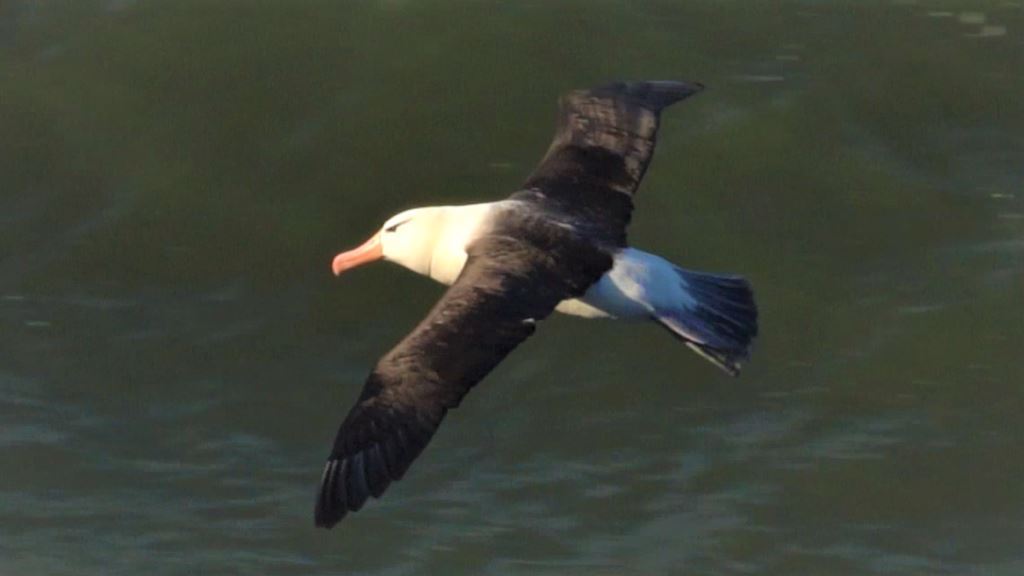A black browed albatross in Yorkshire
When I heard there was a black browed albatross on my doorstep, I packed my cameras and headed out to film it. Watch my film below. 
Albatross off course
The unlikely visitor was spotted at RSPB Bempton Cliffs on the East Yorkshire coast, some 10 thousand miles away from its usual territory. Named for a stripe of dark feathers on along its brow, this birds is normally found in South Atlantic. This one was well off course.
Christmas on the Falkland Islands
I've travelled around the world to see this species, most memorably back in 2006 when my wife and I hired a remote portacabin on Saunders Island. This small island forms part of the Falkland Islands where 70% of the world’s population of black browed albatross breed. It was Christmas and we had no electricity, but we spent our days happily surrounded by penguins and albatross in – even celebrating Christmas day on the cliffs with just the birds for company.
Also known as 'mollymawks'
Classed as a medium-sized albatross, the black browed albatross is nevertheless an impressively large seabird with a wingspan of up to two-and-a-half metres and a dark grey saddle and black upper wings. Also known as a ‘mollymawk’ the species is distinctive from other albatrosses by the nostrils on the side of the bird's large bills. These pastel peach coloured beaks are made up of between seven and nine plates that help them to filter salt from the ocean water.
Chimney pot nests
Black browed albatross breed exclusively in the islands of the South Atlantic on unusual nests that look a bit like chimney pots. Made out of mud and guano, these nests measure about 20 inches high. An albatross lays just a one egg, in early October, into a shallow hollow dug into the top. This egg is fiercely guarded from marauding predators like skuas and after an incubation of nearly three months both parents care for their single large white chick for over four months.
Watching them that Christmas was magical. We were able to wander among the adult birds as they sat on top of their mud-tower nests looking like dignitaries on their thrones as they tended to their chicks. The birds did not seem to mind our presence at all.
Far from home
Outside of the breeding season, this albatross species normally confines itself to the southern oceans. And it was with mixed feelings that I arrived at Bempton Cliffs to see it. It seemed to me more than a little worrying that this bird was so far from home. Bempton Cliffs is host to the Britain’s largest mainland sea bird colony and each summer the cliffs are crowded with gannets, puffins, guillemots, kittiwakes and more.
So, when I arrived at the colony it was surprisingly hard to pick the albatross out from the other birds perched on the bustling cliffs and I had to wait for it to take to the wing before I spotted it. But as soon as it did, it’s sheer size instantly stood out against the other birds circling the cliff tops. It even dwarfed the gannets, which themselves have a wingspan of up to six foot!
Albatross dwarfs gannets
It was breath-taking to watch the albatross’s effortless, beautiful flight as it swirled among the flocks of gannets circling in the sky and, mesmerised, I returned to the same spot for several days to film it. According to the staff at RSPB Bempton, this is the second time a black browed albatross has visited the reserve and they believe it could be the same individual.
Black browed albatross can live for 50 years
Albatrosses can have long lives and there are records of black browed albatross living up to 50 years, but it is thought that this particular one is only about eight years old and so unlikely to have begun breeding yet. Once black browed albatross fledge the nest, they don’t tend to return to their breeding grounds until they are around eight to 10 years old so it is likely this one may have wandered into the northern hemisphere whilst looking for food.
Black-browed Albatross feed largely on fish, lobster-krill and squid and are known to travel long distances to find the best feeding – sometimes more than 200 miles in a single trip. They are also successful scavengers of waste and offal discarded from fishing trawlers.
Albert, Scotland's albatross visitor
Over the years there have been reports of a black-browed albatross named Albert living among a gannet colony in Scotland, although this bird was also a lone individual, so it is likely that the Bempton Cliff albatross was following a food source.
However, I think changes in habitat, plus warmer temperatures may also have something to do with it straying so far and this is worrying. Already this species is in decline, with breeding pairs thought to be decreasing each year. I also read that this individual albatross arrived at Bempton at the end of June after having been chased from cliffs in Denmark by nine white-tailed eagles, which although dramatic, was a sorry tale.
A lonely bird
But if this albatross’s sojourn into Europe has been a lonely avian experience, it did receive a warm welcome from Yorkshire’s birders. In fact bird-spotters from all over the UK massed at the clifftops throughout the summer to see it and it became so popular they even affectionately nicknamed it ‘Albert’.
And although I had mixed feelings about seeing a bird flying so far from home, it was also wonderful to watch it. It was also amazing to think that I once travelled halfway around the world to see this species, and then it turned up right on my doorstep.





